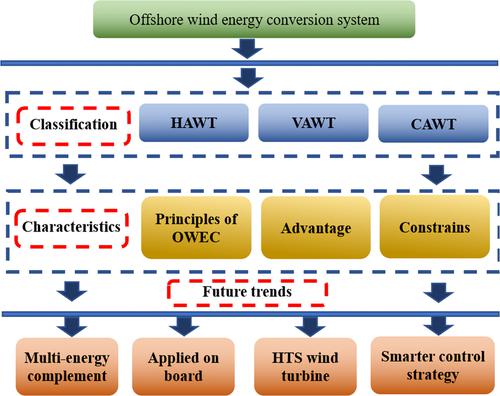当前位置:
X-MOL 学术
›
Int. J. Energy Res.
›
论文详情
Our official English website, www.x-mol.net, welcomes your
feedback! (Note: you will need to create a separate account there.)
A review on development of offshore wind energy conversion system
International Journal of Energy Research ( IF 4.3 ) Pub Date : 2020-09-17 , DOI: 10.1002/er.5751 Jinjiang Li 1 , Guandao Wang 1 , Zhiheng Li 1 , Shaolong Yang 1 , Wen Tong Chong 2 , Xianbo Xiang 1, 3, 4
International Journal of Energy Research ( IF 4.3 ) Pub Date : 2020-09-17 , DOI: 10.1002/er.5751 Jinjiang Li 1 , Guandao Wang 1 , Zhiheng Li 1 , Shaolong Yang 1 , Wen Tong Chong 2 , Xianbo Xiang 1, 3, 4
Affiliation

|
Wind energy conversion system, aiming to convert mechanical energy of air flow into electrical energy has been widely concerned in recent decades. According to the installation sites, the wind energy conversion system can be divided into land‐based wind conversion system and offshore wind energy conversion (OWEC) system. Compared to land‐based wind energy technology, although OWEC started later, it has attracted more attentions due to its significant advantages in sufficient wind energy, low wind shear, high power output and low land occupancy rate. In this paper, the principle of wind energy conversion and the development status of offshore wind power in the world are briefly introduced at first. And then, the advantages and disadvantages of several offshore wind energy device (OWED), such as horizontal axis OWED, vertical axis OWED and cross axis OWED are compared. Subsequently, several major constraints, such as complex marine environment, deep‐sea power transmission and expensive cost of equipment installation faced by offshore wind conversion technology are presented and comprehensively analysed. Finally, based on the summary and analysis of some emerging technologies and the current situation of offshore wind energy utilization, the development trend of offshore wind power is envisioned. In the future, it is expected to witness multi‐energy complementary, key component optimization and intelligent control strategy for smooth energy generation of offshore wind power systems.
中文翻译:

海上风能转换系统的发展综述
旨在将气流的机械能转换成电能的风能转换系统在近几十年来受到广泛关注。根据安装地点,风能转换系统可以分为陆上风能转换系统和海上风能转换(OWEC)系统。与陆基风能技术相比,尽管OWEC的起步较晚,但由于其在风能充足,低风切变,高功率输出和低土地占用率方面的显着优势而引起了更多关注。本文首先简要介绍了风能转换原理以及世界海上风电的发展现状。然后,介绍几种海上风能装置(OWED)的优缺点,例如水平轴OWED,比较垂直轴OWED和交叉轴OWED。随后,提出并综合分析了一些主要限制因素,例如复杂的海洋环境,深海电力传输以及海上风能转换技术面临的昂贵的设备安装成本。最后,在总结和分析一些新兴技术以及海上风能利用的现状的基础上,展望了海上风能的发展趋势。未来,预计将见证多能量互补,关键组件优化和智能控制策略,以实现海上风力发电系统的平稳发电。介绍并综合分析了海上风电转换技术所面临的深海电力传输和昂贵的设备安装成本。最后,在总结和分析一些新兴技术以及海上风能利用的现状的基础上,展望了海上风能的发展趋势。未来,预计将见证多能量互补,关键组件优化和智能控制策略,以实现海上风力发电系统的平稳发电。介绍并综合分析了海上风电转换技术所面临的深海电力传输和昂贵的设备安装成本。最后,在总结和分析一些新兴技术以及海上风能利用的现状的基础上,展望了海上风能的发展趋势。未来,预计将见证多能量互补,关键组件优化和智能控制策略,以实现海上风力发电系统的平稳发电。
更新日期:2020-09-20
中文翻译:

海上风能转换系统的发展综述
旨在将气流的机械能转换成电能的风能转换系统在近几十年来受到广泛关注。根据安装地点,风能转换系统可以分为陆上风能转换系统和海上风能转换(OWEC)系统。与陆基风能技术相比,尽管OWEC的起步较晚,但由于其在风能充足,低风切变,高功率输出和低土地占用率方面的显着优势而引起了更多关注。本文首先简要介绍了风能转换原理以及世界海上风电的发展现状。然后,介绍几种海上风能装置(OWED)的优缺点,例如水平轴OWED,比较垂直轴OWED和交叉轴OWED。随后,提出并综合分析了一些主要限制因素,例如复杂的海洋环境,深海电力传输以及海上风能转换技术面临的昂贵的设备安装成本。最后,在总结和分析一些新兴技术以及海上风能利用的现状的基础上,展望了海上风能的发展趋势。未来,预计将见证多能量互补,关键组件优化和智能控制策略,以实现海上风力发电系统的平稳发电。介绍并综合分析了海上风电转换技术所面临的深海电力传输和昂贵的设备安装成本。最后,在总结和分析一些新兴技术以及海上风能利用的现状的基础上,展望了海上风能的发展趋势。未来,预计将见证多能量互补,关键组件优化和智能控制策略,以实现海上风力发电系统的平稳发电。介绍并综合分析了海上风电转换技术所面临的深海电力传输和昂贵的设备安装成本。最后,在总结和分析一些新兴技术以及海上风能利用的现状的基础上,展望了海上风能的发展趋势。未来,预计将见证多能量互补,关键组件优化和智能控制策略,以实现海上风力发电系统的平稳发电。











































 京公网安备 11010802027423号
京公网安备 11010802027423号